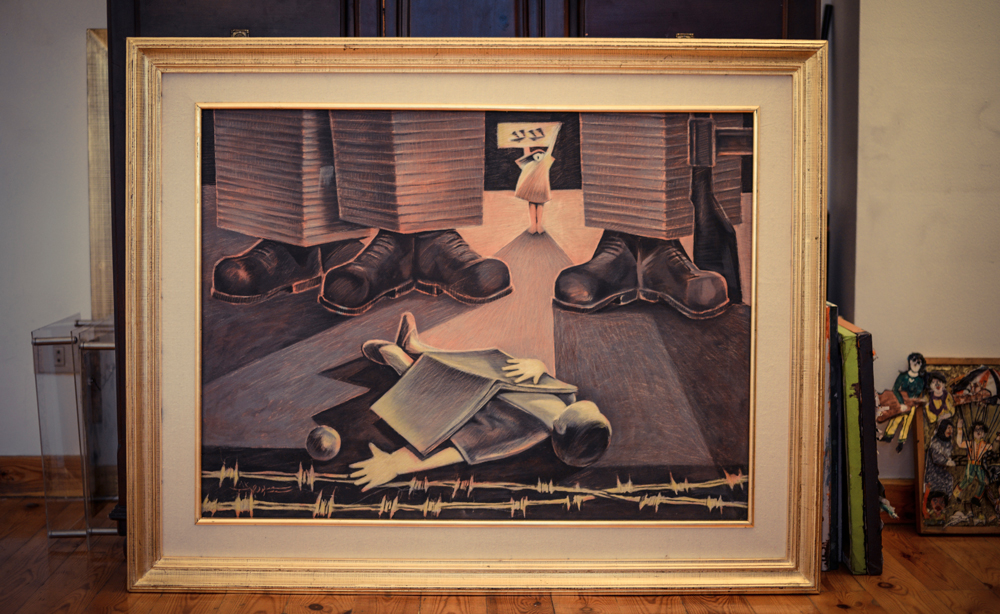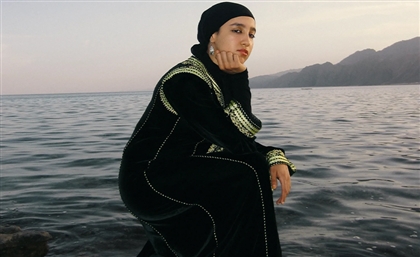Circles In The Sand: Saad el Din’s Stunning Paintings Depict A Shadowy Egypt
Artist Sayed Saad el Din opens his most recent exhibition, Circles in the Sand, and talks to our Sanabel al-Najjar about the art experience, the homeland, and the concept of the universal human being.

There are certain – perhaps peculiar – habits that we practise subconsciously at times. Some of us might, when feeling upset or at a loss with this confusing mess of a world, find ourselves completely lost in paintings and in search of a certain one whose feel has already been absorbed by our minds. How many times did we stop, arrested, by a stare of a timid face in an Alexei Harmaloff painting? How many times did we absorb to the bone the deep colours of a certain shadow cast upon a distant figure in a one of Jean Lean Gerome’s masterpieces? How many times did we stare for the longest time at the explosion of bright colours ironically depicting a broken woman in Pablo Picasso’s Weeping Women series? How many times did we wish to dive into a painting and remain there – even if temporarily?
Art has always told a story and electrocuted our soul with a breath of life, whether we were receptive of it or not. Its humane authority is established and is sometimes irrelevant to our taste or even appreciation for art.
Renowned Egyptian artist Sayed Saad el Din does just that and, through his paintings, carries our souls to nostalgic and intimately familiar but blurred places in our minds. Whether it’s a Nubian man with a beautiful skull structure playing the oud with a pyramid behind him and the moon big in the sky, or two lovers kissing in front of a lake, or a woman drawing a square around herself using chalk, the themes in his paintings as well as his very distinctive style leave a stain of colour on our souls.
I recently had the wonderful chance to visit Saad el Din’s Circles in the Sand, an exhibition held at Art Talks Egypt in collaboration with Absolut, and see his paintings in real life, which were – to my surprise – much larger in size and even richer in feel and impression. The artist was kind enough to sit down and have a very interesting conversation with me about the role of art in human life and his strong affinity to his Egyptian roots and culture.

My favourite painting by Saad el Din is called Virgins and shows a group of bathing woman, with some of them holding delicate see-through sheets. The painting was inspired by poet Ahmad Shawqi. No wonder! El Kanaseen (The Sweepers), showing a group of three vague-faced men sweeping the floors, is another stunner.
Given my childlike excitement about discussing something art-related with an actual artist, I decided I would dive right into it and ask Saad el Din about two prominent characteristics in his paintings that really make for his personal style: space (including shadows) and the very edgy lines of his human as well as inanimate figures.
Saad el Din started off with a clear statement that really set everything in order regarding the type of messages he tries to convey through his paintings, and which are easily observable by anyone presented with one of his works. “I call myself an artist of human beings and of the motherland (al watan); those two are the causes I fight for,” Saad el Din said. “Because, you see, each artist has a certain outlook on life and a certain mode of thought, and just like a writer or a poet, I have a message too, and it’s about the universal human being in general as well as the Egyptian person specifically."

The artist then fondly listed the many elements of Egyptian culture that are dear to his heart and which have a great influence on him, such as the Nile, the people of Egypt, its pyramids, its fellahin, its workers, and so on. “I try to bring out the image of the Egyptian in my works as well as the human being in general. I hate violence, ugliness, disputes, wars, and whatever causes the human being distress and frustration."
Saad el Din then explained to me that an artist would take those themes he or she is interested in and artistically translate them, crafting through them the artist's own style. “So, the shadow in my paintings is used to indicate the presence of someone, as there can be no shadow without an object, or is there to indicate the traces of someone who was present and is there no more,” he elaborated.

I, of course, ecstatic with my observation, had to interrupt at this point and bring up to him how I’ve noticed that, in his paintings, the human subject is usually isolated from his or her surroundings, and that, in many paintings, the women would be caught up with their full attention going to objects such as the moon instead of fellow people. Why?
“Of course, my paintings are not completely realistic or photographic, and there is a strong use of symbolism in my works," Saad el Din explained. "The sun, just like the moon in my paintings, symbolises hope - a source of light against desperation and ugliness. The moon disperses the darkness of the night.”

The artist’s paintings are not without clear references to Egypt and his loving perception of the country. In fact, most of his works include aspects such Egyptian traditional dress, desert, pyramids, and figures with Nubian features. Saad el Din explained to me that this comes out of his great love for Egypt and taking pride in a civilisation that has offered so much to humanity.
When asked whether he sees that the current generation is offering a lot when it comes to art, Saad el Din actually expressed his disappointment and told me that “art should not be made for art’s sake, and I see that only some of the younger generation of artists take the issue seriously and really affect others. The artist should be a mirror of his or her generation, and through their works you should be able to tell a lot about the people they were around, as well as the times they lived in.”
During our conversation, Saad el Din narrated to me how he had to resist family pressure and forcefully change majors from construction engineering to art after he dropped out of the university he was initially enrolled in, and applied to the Leonardo da Vinci Art Institute. All I could think when he said that was thank the skies that artists have always fought to do what they love and share the splendours of this life with us to relate to and lose ourselves in.
One can only hope that Saad el Din’s paintings and his approach to life will always inspire us.

To see more of the artist’s work, check out his Facebook page.
Photo shoot by @MO4Ntetwork's #MO4Productions
Photography by Ahmed Najeeb























